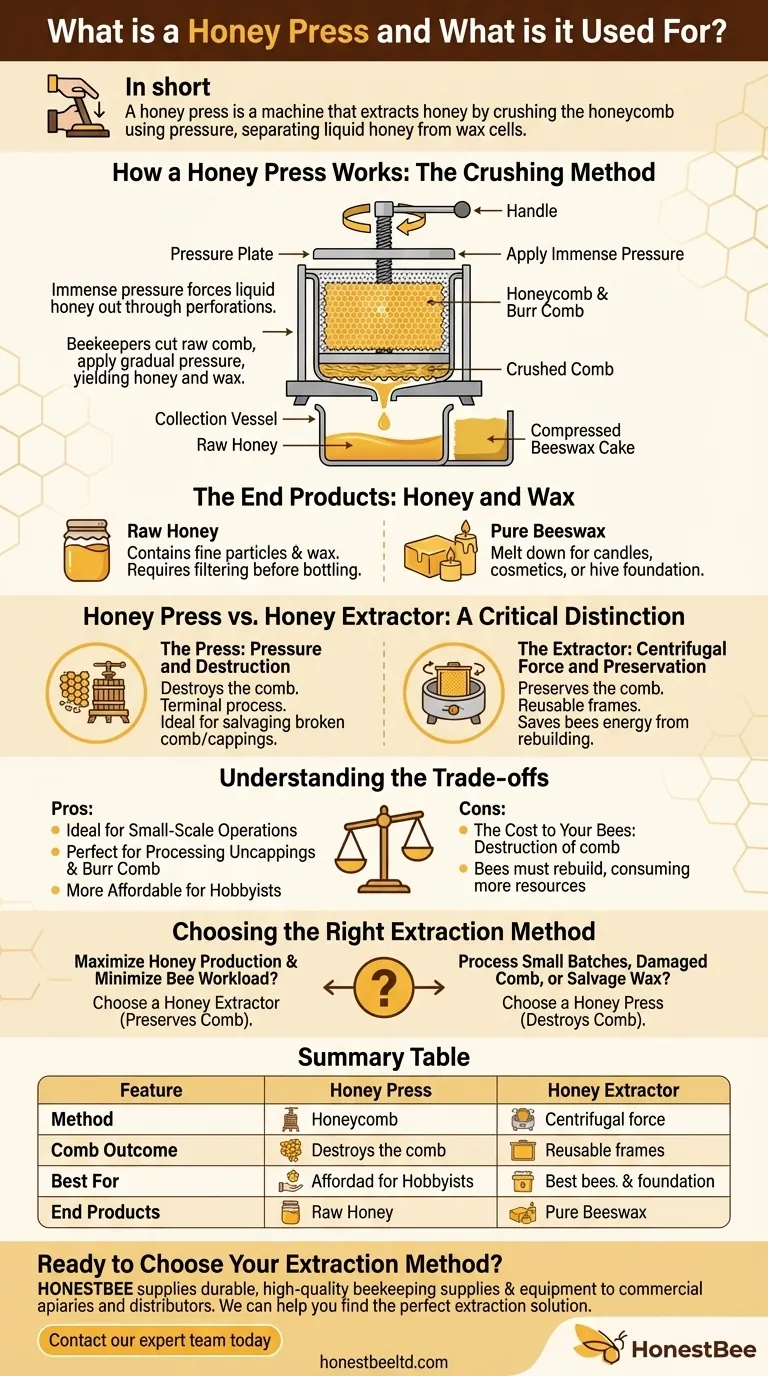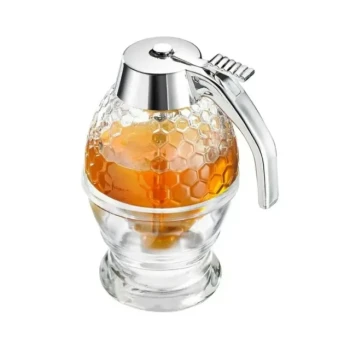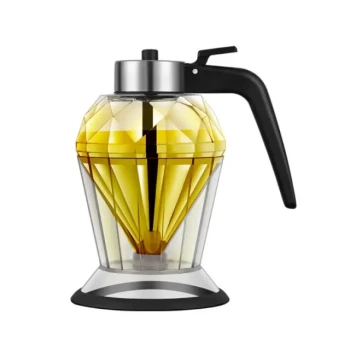In short, a honey press is a machine that extracts honey by crushing the honeycomb. It uses pressure, typically from a screw or a plate, to squeeze the honey out of the wax cells. This method is distinct from a honey extractor, which uses centrifugal force to spin honey out of the comb without destroying it.
A honey press is a simple, effective tool for small-scale beekeepers that separates honey from wax by physically crushing the comb. This process yields both liquid honey and a block of pure beeswax but requires the bees to rebuild the comb from scratch.

How a Honey Press Works: The Crushing Method
A honey press operates on a straightforward principle: applying force to separate a liquid from a solid. This is fundamentally different from the spinning action of a centrifugal extractor.
The Basic Mechanism
The most common designs, like a bucket or screw press, feature a perforated container to hold the honeycomb and a pressure plate. As you turn a handle or screw, the plate presses down on the comb.
This immense pressure crushes the wax cells, forcing the liquid honey to flow out through the perforations in the container.
The Step-by-Step Process
First, the beekeeper cuts the raw honeycomb from its frame and places it into the press's container. The pressure is then gradually applied.
The extracted honey drains into a collection vessel below. What remains in the press is a compressed cake of beeswax.
The End Products: Honey and Wax
This process yields two valuable products: raw honey and pure beeswax. The honey will contain fine particles of wax and other hive debris, so it must be filtered through a fine mesh or cheesecloth before bottling.
The leftover beeswax can be melted down and used for candles, cosmetics, or foundation for new hive frames.
Honey Press vs. Honey Extractor: A Critical Distinction
The terms "press" and "extractor" are sometimes used interchangeably, but they describe two very different processes with different outcomes for the beekeeper and the bees.
The Press: Pressure and Destruction
A honey press destroys the comb to get the honey. It is a terminal process for that specific piece of comb.
Its primary advantage is its simplicity and its ability to salvage honey from broken or irregular pieces of comb, such as burr comb or wax cappings.
The Extractor: Centrifugal Force and Preservation
A honey extractor preserves the comb. It spins frames at high speed, and the centrifugal force flings the honey out of the cells while leaving the wax structure intact.
The beekeeper can then return the empty "wet" frames to the hive. This saves the bees an enormous amount of energy, as they do not have to produce wax and rebuild the comb from nothing.
Understanding the Trade-offs
Choosing a press involves weighing efficiency and simplicity against the impact on your bee colony. It is an excellent tool, but it's not universally superior to an extractor.
Ideal for Small-Scale Operations
For a hobbyist with only one or two hives, a press is often more practical and affordable than a larger, more expensive extractor. It excels at processing a small quantity of comb.
Perfect for Processing Uncappings and Burr Comb
Even beekeepers who own an extractor often use a press. When you uncap honey frames before extraction, you are left with wax cappings rich with honey. A press is the perfect tool to separate this honey from the wax.
The Cost to Your Bees
The most significant trade-off is the destruction of the comb. Bees must consume a large amount of honey (or nectar) to produce a small amount of wax. By returning empty drawn comb, you give your colony a huge head start on the next honey flow.
Choosing the Right Extraction Method
Your beekeeping goals and the scale of your operation should dictate your choice of equipment.
- If your primary focus is maximizing honey production and minimizing bee workload: A centrifugal honey extractor is the superior choice because it preserves the valuable drawn-out comb.
- If your primary focus is processing small batches, dealing with damaged comb, or salvaging wax: A honey press is an invaluable, efficient, and often more affordable tool.
Ultimately, understanding the function of each tool allows you to work more effectively and sustainably with your bees.
Summary Table:
| Feature | Honey Press | Honey Extractor |
|---|---|---|
| Method | Crushes comb with pressure | Spins comb with centrifugal force |
| Comb Outcome | Destroyed | Preserved and reusable |
| Best For | Small batches, cappings, burr comb | Maximizing honey production, larger operations |
| End Products | Raw honey & pure beeswax | Liquid honey only |
Ready to Choose Your Extraction Method?
Whether you're a hobbyist starting with a honey press or a commercial apiary scaling up with extractors, having the right equipment is key to a successful harvest.
HONESTBEE supplies durable, high-quality beekeeping supplies and equipment to commercial apiaries and beekeeping equipment distributors through our wholesale-focused operations. We can help you find the perfect extraction solution for your needs.
Contact our expert team today to discuss your operation and get a quote on the equipment that will help your business thrive.
Visual Guide

Related Products
- Electric Honey Press Machine for Squeezing Honey Comb Press Equipment
- Stainless Steel Manual Honey Press with Guard for Pressing Honey and Wax
- Honey Wax Separating Wax Press with Metal Screw Wax Separator Machine
- 10L Stainless Steel Electric Honey Press Machine
- Stainless Steel Honey Press Wax Press with Tank
People Also Ask
- What are the benefits of using a honey press for Warré or Top Bar beehives? Maximize Your Natural Harvest
- Why are honey presses particularly useful for beekeepers using Top Bar hives? Maximize Your Harvest
- What are the reasons for choosing a honey press over a dedicated honey extractor? Maximize Disease Control and Natural Beekeeping
- What are the unique characteristics of honey presses? Maximize Honey Yield for Small-Scale Beekeeping
- How does a honey press work? A Guide to Simple, High-Yield Honey Extraction



















